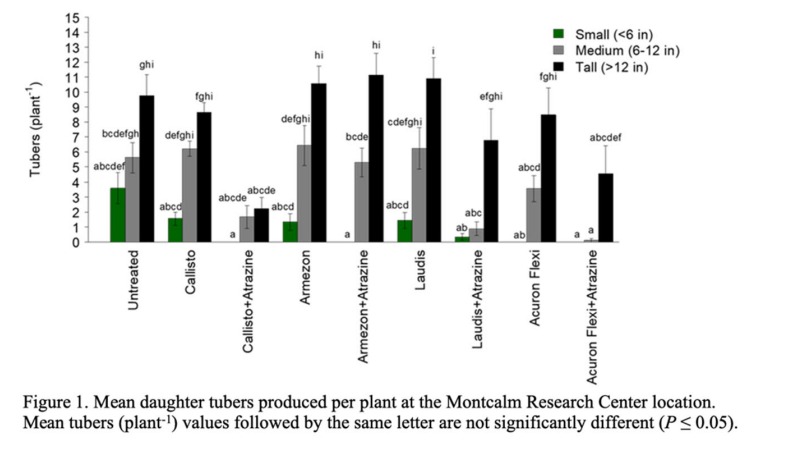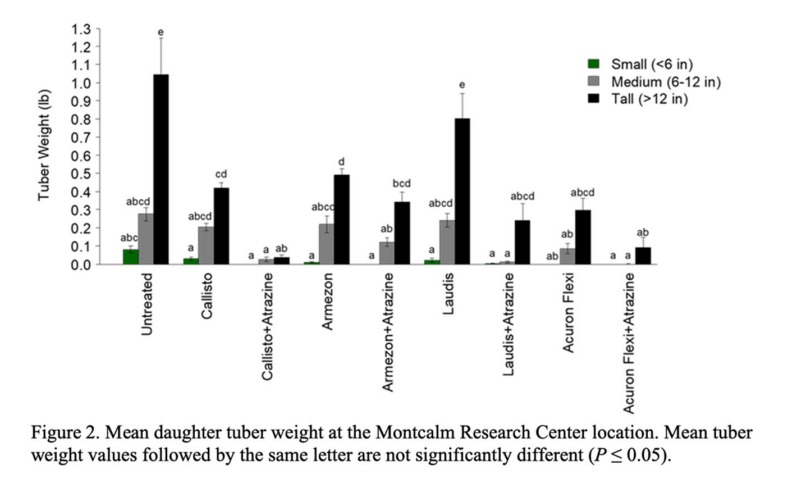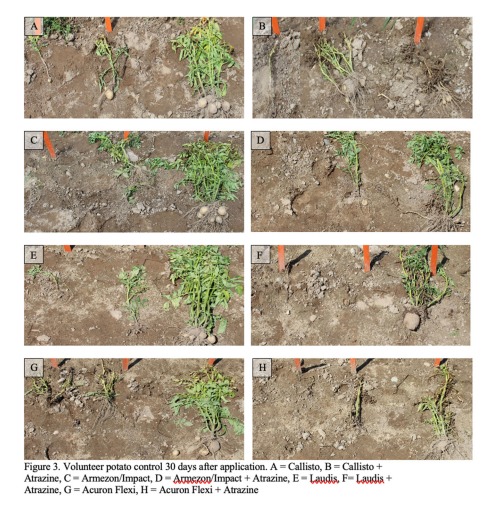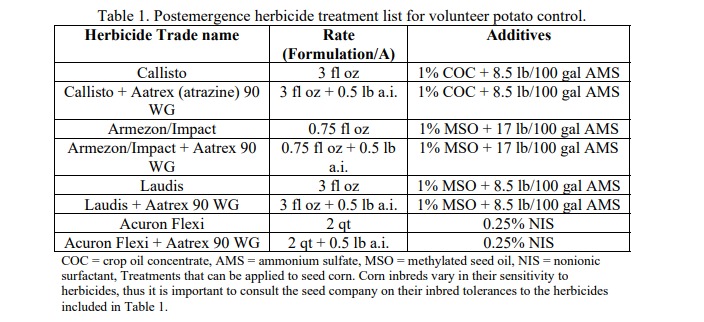In recent years, fewer areas experience extreme cold winter temperatures. The winter of 2022-2023 was the ninth warmest on record for the Midwest, as a whole. Six states in the Midwest had a top 10 warmest winter with Michigan experiencing the sixth warmest winter on record. December was slightly cooler than normal but unremarkable in the historical rankings. Conversely, the Midwest had its fourth warmest January and its 15th warmest February (Midwestern Regional Climate Center). What does this mean for managing volunteer potatoes and Colorado potato beetles that feed on them?

Historically, harsh winter temperatures kill tubers that remain in the field after harvest. Although, in regions where winters are mild and soil temperatures are not cold enough to kill tubers left in the field, tubers can survive overwinter and become a serious weed problem the following spring. Not only do volunteer potatoes compete with crops and reduce yield, but they also harbor insects, diseases, and nematodes that can infest neighboring or future potato crops.
Volunteer potatoes are difficult to control. Currently, there are no herbicides available that will completely control volunteer potatoes and significantly reduce the number of daughter tubers produced per plant. The MSU potato research team conducted volunteer potato control studies in 2018 and 2019 to investigate potential volunteer control options in corn (Table 1, below). Results in Figures 1-3 highlight two important facts. First, the addition of atrazine to herbicide treatments improved control. Second, as the size of volunteer potatoes increased control decreased. When applications were made to small volunteers

(<6 in) 60% of treatments resulted in one or no daughter tubers produced per plant. When applications were made to medium (6-12 in) or tall (>12 in) only 25% and 0% of treatments resulted in one or no daughter tubers produced per plant (Figure 1). A similar trend was observed in mean daughter tuber weight (Figure 2). In addition to the treatments outlined in Table 1, we also tested glyphosate in both years.
In 2018 glyphosate provided little control, in contrast in 2019 glyphosate was highly effective at controlling volunteers. Given this variability if glyphosate is applied to control volunteers scout fields two weeks after application to ensure sufficient control. Finally keep in mind your plans for future rotational crops and consult Table 12-Herbicide Crop Rotation Restrictions in the 2023 MSU Weed Control Guide for rotation restrictions. The Michigan Potato Industry Commission

supported this research. Volunteer potatoes are not only a problem in corn, but potentially other crops grown in rotation with potatoes. We have not investigated control in other crops, but research from other universities has shown various levels of control or suppression with the following:
- Control in winter wheat: Utilize group 4 herbicides (2,4-D, dicamba, MCPA, starane, stinger) and group 27 (Huskie).
- Control in soybean: Reflex (fomesafen), Raptor (imazamox), Roundup (glyphosate), approved dicamba and 2,4-D. Ensure soybean traits allow postemergence applications of these herbicides.
- Control in dry bean: Raptor (imazamox), Basagran (bentazon).
- Control in alfalfa: Raptor (imazamox), Pursuit (imazethapyr-methyl), 2,4-DB.
- Control in sugarbeet: Nortron (ethofumesate), Stinger (clopyralid).
What do warmer winters mean for overwintering success of Colorado potato beetles? All insects-including Colorado potato beetle depend completely on ambient temperature for their development and survival during overwintering. Entomologists have discovered that overwintering beetles survive better when soil temperatures stay around 32ºF and that beetles tend to remain in the top 10 inches of soil if winter temperatures are warmer*, instead of having to expend energy to dig deeper. Sudden cold exposures, during for example a polar vortex, can drastically decrease overwintering beetle numbers. So, this past winter’s warm temperatures

may have been conducive to high overwintering success. This means plenty of adult beetles emerging in spring to cause issues. Volunteer potatoes in the spring can provide emerging overwintered beetles with food and if the volunteers aren’t eliminated, they will continue to provide beetles with food during the growing season. Therefore, the most effective way to reduce Colorado potato beetles is to destroy the potato volunteers in the first place.
If volunteer potatoes aren’t effectively eliminated, then beetles will need to be controlled. Volunteer potatoes and beetles will be located in the field where potatoes were grown last year, and if crops are rotated, now a different crop is planned to be produced. This provides a challenge because insecticides that are registered for use in potatoes for Colorado potato beetle management cannot necessarily be used in other crops. For example, if field corn is being grown this year in last year’s potato field, there are only a few insecticide options (Coragen, Radiant or Blackhawk) that can be used as foliar sprays to kill the adult beetles in the corn before they move over into the new potato field that might be nearby. This strategy would only work when the corn is still young and the spray can reach the volunteer potatoes and the beetles feeding on them. While many pyrethroid insecticides are registered in many different field crops, Colorado potato beetles are resistant to this class of insecticides, thus they won’t die after spraying. Coragen and Radiant are expensive insecticides, thus it may be worthwhile spraying the edge of the field only where it is closest to the nearest potato field or spray only the beetle hot spots.
If beetles surviving on volunteer potatoes are still a problem well into the growing season, a trap crop might help reduce migration into nearby potato fields. Using potatoes as trap crops can be done by planting a few rows of potatoes along the field margin where beetles are and treating them with an insecticide to stop beetles from moving into nearby potato fields. This strategy has numerous disadvantages: beetles won’t always stay on the trap crop and repeated exposure to insecticides may increase insecticide resistance.
For a more on potato insect management from MSU Vegetable Entomology, click here.
– By Erin Burns, Michigan State University Weed Science Program, and Zsofia Szendrei, Michigan State University Department of Entomology
*Milner, M., Kung, K-J.S., Wyman, J.A., Feldman, J., Nordheim, E. (1992) Enhancing overwintering mortality of Colorado potato beetle (Coleoptera: Chrysomelidae) by manipulating the temperature of its diapause habitat. J. Econ. Entomol. 85(5): 1701-1708.
